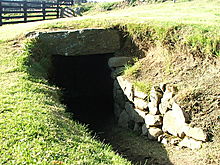|
|
|
|
Culsh SouterrainSouterrain
|
||||||||||||||||||||||||
|
|
|
Images (click to view fullsize) |
|
Photographs:













 Maps / Plans / Diagrams:
Maps / Plans / Diagrams:
|
Fieldnotes |
|
|
We didn't have a definite plan for today's itinerary, although I was keen to see Culsh Souterrain. As we headed off, we were once again astounded by the weather which was already hot and sunny. Culsh was my first (and, so far, only) souterrain so I was quite excited as we pulled up in a very small lay-by. The entrance gives no indication as to what lies within and we got our torches out, ready for a bit of investigation. Unfortunately for Vicky, who isn't best suited to dark, damp places the experience wasn't too pleasant, and she decided to give it a miss so I headed in alone, struggling to make sense of what I was (barely) seeing in the torch-light. I loved the red granite stone, which was easy to make out with the little light I had and I was pleased to have read before-hand about the cup marked stone in the entrance, otherwise I am sure I would've missed it! This post appears as part of the weblog entry Aberdeenshire Antics
|
 Posted by Vicster
Posted by Vicster28th February 2010ce |
|
This is too easy to miss, right on a corner, and with such a tiny entrance that even the sign pointing clearly to the entrance makes you think 'where'? But it's huge! After an initial squeeze down into the banana shaped souterrain, the head height is more generous and I was able to stand up. Treading carefully, as my torch didn't seem to penetrate the gloom whatsoever, I paced it out at 16 paces and counted seven capstones! Wow! After the relentless Aberdeenshire sun (and you don't get to write that very often) the fridge coolness of the earth house was most welcome. This was surely a prehistoric food store-cum-bank-cum-insurance policy. This post appears as part of the weblog entry Hot stuff in Aberdeenshire: stone-baked
|
 Posted by Jane
Posted by Jane30th July 2006ce |
|
Culsh Souterrain (22.8.2002) Culsh Souterrain is VERY close to the main road (the B9119), just West of Tarland, but because it's not at all visible you could easily go past it. It's right on the bend in the road and is marked on some Road Atlases. I came from the west, because it's not far from the Tomenaverie Circle. This souterrain is given a whole page in Janet and Colin Bord's excellent 1978 book, 'A Guide to Ancient Sites In Britain', but only a brief mention in TMA (pg 93). The Bord book says you can borrow a torch at Culsh Farm if you need but I'd suggest bringing your own because the house next to the Souterrain now looks distinctly unfriendly with its 'No Parking' sign and chunky big gate. You can just about park off the road near this house's driveway and not get in anyone's way. The entrance to the souterrain is literally 7 metres down from the edge of the road - I somehow expected more of a trek! There is an info board on the grass just a few metres above entrance to the souterrain and you can't see the entrance until you walk a few metres closer - weirdly shocking. I wasn't prepared, and hadn't brought a torch (doh!). My lighter was fine for a while as I walked further into the underground but became red hot by the time I was in the central part. So on the way out I edged out slowly in pitch blackness. Things like this amaze me. It seemed so long that surely it was underneath the road?! What the hell is going on here? I'm walking (you can almost stand up in the tunnel, and can easily stand up in the main circular bit) into an underground building in the middle of no where on a rainy afternoon in summertime. Moments like this make life great. I've just found a link to this site and it says it is over 14m long?! Is that right? Wow, no wonder it seemed to go on for ages. The picture on the link is fantastic. |
 Posted by pure joy
Posted by pure joy28th November 2002ce Edited 9th February 2003ce |
Miscellaneous |
|
An underground chamber was discovered on the farm of Culsh, about two miles distant from the Church of Tarland, which was cleared out in my presence in the month of August last, and which I shall now endeavour to describe. The cave occurs on a slope, the entry to it being so contrived as not to attract notice. Its extreme length is about 47 feet, it is curved in shape, and closely resembles in form the chamber near Newstead, Roxburghshire.From the Aberdeen Journal Notes and Queries v3, 1908. |
 Posted by Rhiannon
Posted by Rhiannon2nd February 2013ce Edited 2nd February 2013ce |
Links |
|
Extreme Stonefeelers' World of Hard Rock & Standing StonesPics of Culsh Souterrain. |
 Posted by new abbey
Posted by new abbey11th April 2010ce Edited 11th April 2010ce |
Stone Pages - ancient sites of scotlandFantastic photo of the souterrain tunnel and some info |
 Posted by pure joy
Posted by pure joy28th November 2002ce |

